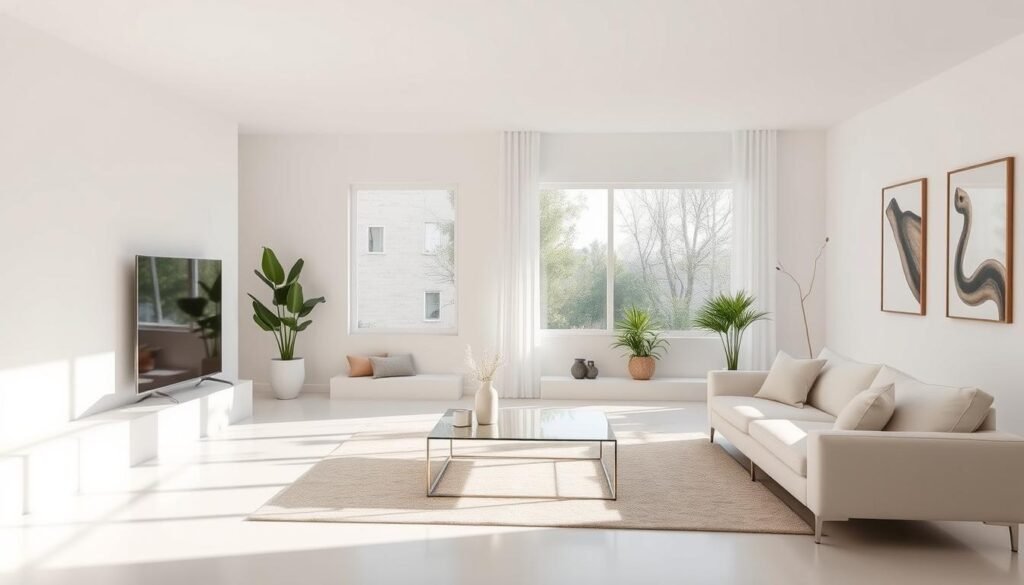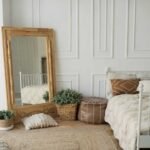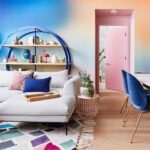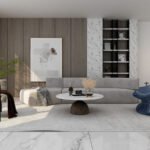Minimalist home design is all about simplicity and clean lines. It means getting rid of things you don’t need. This makes your home calm and easy to clean.
By choosing minimalism, you cut down on visual stress. It also makes your home look better. Plus, it’s easier to keep clean.
A minimalist home has less furniture and clear surfaces. It values quality over having lots of things. To achieve this, you need to declutter carefully, choose simple furniture, and stick to neutral colors.
Minimalism is more than just a design choice. It’s a way of life. It brings calm, peace, and happiness to your home.
Key Takeaways
- Minimalist design focuses on simplicity, clean lines, and uncluttered spaces.
- It involves stripping away non-essential items to create a calm and functional living environment.
- Minimalist homes feature limited furniture, clear surfaces, and prioritize quality over quantity.
- Decluttering, simplifying furniture, and choosing a neutral color palette are key steps in the process.
- Minimalism is a lifestyle that brings a sense of calm, peace, and satisfaction to the home.
Understanding the Benefits of Minimalist Living
Living with a minimalist design brings many benefits that improve our well-being. At its core, it’s about choosing what’s truly important. Every item in a minimalist space has a purpose, making it calm and focused.
Reduced Stress and Visual Clutter
A minimalist space gets rid of visual clutter. This means fewer distractions and a calmer environment. Living in a cluttered space can make us feel anxious and stressed.
A minimalist space look brings order and peace. It helps our minds relax and focus better.
Easier Maintenance and Cleaning
Minimalist interior design focuses on simplicity and function. With fewer things, cleaning is easier. This saves time and makes us feel more in control.
Enhanced Mental Well-being
Minimalist living also boosts our mental health. It reduces distractions, creating a calm space. This helps us stay focused and feel more grounded.
Studies show that living simply can lower stress and depression. It lets us enjoy our surroundings and focus on what’s important.
“The ability to simplify means to eliminate the unnecessary so that the necessary may speak.” – Hans Hofmann
Choosing minimalist living can change our lives for the better. It leads to a more intentional and fulfilling life. By understanding its benefits, we can create a peaceful, harmonious home.
Core Principles of Minimalist Design

The minimalist design movement started in the late 1960s and early 1970s. It was led by the American visual art movement. This philosophy focuses on simplicity, functionality, and intentionality. It highlights the essential elements and clear lines, avoiding too much detail or decoration.
Minimalist design often uses a simple color palette like gray, white, and black. It also uses natural materials. The aim is to create calm, open spaces. This movement has also shaped minimalist architecture and web design, emphasizing simplicity and function.
At its core, minimalist design is about living intentionally. Every element is chosen for its purpose and value. This philosophy encourages decluttering, choosing functional furniture, and keeping decor simple. By following these principles, people can live a lifestyle that is both beautiful and refreshing.
| Key Principles of Minimalist Design |
|---|
| Simplicity |
| Functionality |
| Intentionality |
| Neutral Color Palette |
| Open Spaces |
| Natural Materials |
The history of minimalist design has greatly influenced various fields, including graphic design and architecture. By sticking to minimalist principles, designers can create designs that are both striking and emotionally engaging. These designs connect well with today’s audience.
“Minimalism is not a lack of something. It’s simply the perfect amount of something.” – Nicholas Burroughs
Starting Your Minimalist Journey: Room-by-Room Approach

Starting a minimalist lifestyle doesn’t have to feel huge. Take it one room at a time. This way, you stay motivated and make a smooth transition to a minimalist style and minimalist look in your home.
Decluttering Process and Organization
Start by cleaning out each room. Put things into three piles: keep, donate, and throw away. This clears out physical clutter and frees your mind from too much stuff. Think about minimalist architects and how they use space wisely.
Furniture Selection and Placement
After decluttering, pick out key furniture that does more than one thing. Don’t fill your space with too much. Arrange furniture to make room for movement and to feel open, using minimalist color and minimalist design.
Storage Solutions and Space Optimization
Use smart storage to make the most of your space. Try built-in shelves, under-bed storage, and hidden spots to keep things tidy. Keep these areas organized to keep your minimalist look going strong.
By focusing on one room at a time, you can turn your home into a peaceful, minimalist style space. This step-by-step approach helps you stay on track and enjoy the journey of minimalism.
“The first step in crafting the life you want is to get rid of everything you don’t.”
– Joshua Becker, “The Minimalist Home”
Essential Elements of Color and Materials

Creating a minimalist home involves smart choices in color and materials. A neutral color palette and high-quality, natural materials are key. They help make your home look clean, timeless, and uncluttered.
Choose a monochromatic color scheme with white, beige, and soft grays. These colors make your space feel calm and open. Stay away from bold, vibrant colors that can mess up the minimalist vibe.
Add warmth and texture with natural elements like wood, stone, and plants. These materials fit well with minimalist design, adding a touch of elegance. Choose sustainably sourced and eco-friendly materials to support the minimalist lifestyle of intentional living and waste reduction.
Use small pops of color with throw pillows, artwork, or decorative objects. These touches add interest without ruining the minimalist look.
Always choose quality over quantity in materials and finishes. Go for durable, timeless pieces that last, not trendy or cheap ones. This focus on quality is what makes a minimalist interior designer’s work stand out.
“Less is more when it comes to minimalist design. Focus on clean lines, natural materials, and a neutral color palette to create a serene and uncluttered living space.”
By carefully picking your colors and materials, you can create a minimalist home. It will be calm, sophisticated, and reflect a life of intention.
Creating Balance Through Décor and Accessories

Creating balance in a minimalist home is about picking the right décor and accessories. It’s about finding a mix that’s both useful and beautiful. Each item should add something special without making the space feel too busy.
Natural Elements and Lighting
Use natural materials and lighting to make your space calm and peaceful. Let in as much natural light as you can by using light curtains or mirrors. Add plants or wooden pieces to bring in a touch of nature and match the room’s simple style.
Accent Pieces and Artwork
Choose a few decorative items that fit the room’s colors and style. Pick pieces that look good and serve a purpose, like a unique vase or minimalist art. Don’t overdo it with too many decorations.
Textiles and Textures
Add warmth and interest with natural materials and textures. Choose high-quality fabrics like linen or wool. They’ll make your space cozy and inviting without losing its simplicity.
The goal of minimalist design is to create a space that’s both beautiful and functional. By carefully choosing your décor and accessories, you can make a balanced and stylish home that shows off your personal taste.
“Every piece of furniture, every accessory, every detail should have a purpose and contribute to the overall design.”
Also Read : Modern Styling Hacks For A Fresh And Functional Home
Conclusion
Living a minimalist lifestyle is more than just having fewer things. It’s about changing how you think and live. It’s about making a space that shows what’s important to you.
Remember, minimalist design doesn’t mean you have to give up comfort or style. It’s about creating a peaceful and clear space. This space should make you feel calm and happy.
As you move forward with minimalist design, remember it’s for you. Make it fit your life and needs. Start small and be kind to yourself. Aim to make a home that brings you peace and joy.
Living a minimalist lifestyle has many benefits. It can reduce stress, make cleaning easier, and help the planet. These are all good things.
In the end, minimalist design is not just about looks. It’s about living with purpose and intention. By choosing “less is more,” you can create a space that’s good for you. This space will make your life better.
FAQs
Q: What are the characteristics of minimalist interior design?
A: The characteristics of minimalist interior design include simplicity, functionality, and a lack of ornamentation. This design style focuses on clean lines, open spaces, and a limited color palette, often emphasizing natural materials.
Q: How can I create a minimalist space in my home?
A: To create a minimalist space, you should declutter your home by removing unnecessary items, choose furniture with simple lines, and select a neutral color palette. Incorporating multifunctional furniture can also enhance the minimalist look.
Q: What is the history of minimalist interior design?
A: Minimalism as a design movement emerged in the mid-20th century, influenced by modernism and Japanese aesthetics. It emphasizes “less is more,” promoting simplicity and functionality in both architecture and interior design.
Q: What elements are essential in a minimalist interior?
A: Essential elements of a minimalist interior include an open floor plan, natural light, a restricted color palette, and carefully chosen furnishings that serve a purpose. Every piece should contribute to the overall harmony of the space.
Q: How does minimalist design differ from Scandinavian design?
A: While both minimalist and Scandinavian designs emphasize simplicity and functionality, Scandinavian design often incorporates warm textures and colors, creating a cozy atmosphere. Minimalist design tends to focus more on stark simplicity and fewer decorative elements.
Q: What are the best color palettes for minimalist interior design?
A: The best color palettes for minimalist interior design typically include whites, grays, and earth tones. These colors help create a serene atmosphere and allow the design elements to stand out without overwhelming the space.
Q: Can minimalist design principles be applied to web design?
A: Yes, minimalist design principles can be effectively applied to web design. This approach often results in clean layouts, intuitive navigation, and a focus on essential content, enhancing user experience by reducing clutter.
Q: How does one embrace the art of minimalism in their home?
A: Embracing the art of minimalism involves prioritizing quality over quantity, investing in timeless design pieces, and being intentional about what you bring into your space. It’s about living with less and appreciating the space you create.
Q: What are some common design ideas for a minimalist dining room?
A: Common design ideas for a minimalist dining room include a simple dining room table with clean lines, minimal decor, and natural materials. Consider using a monochromatic color scheme and opting for functional tableware to maintain the minimalist aesthetic.
Q: How can I achieve a minimalist look in small spaces?
A: To achieve a minimalist look in small spaces, focus on maximizing functionality with multifunctional furniture, use a light color palette to create an airy feel, and keep decor to a minimum to avoid visual clutter.





